PROPAGANDA: Re-imagining the Conquest: contested histories
Published in Features, Issue 3 (May/June 2019), Volume 27By Clare O’Halloran
In 1777, a performance of John O’Keeffe’s comedy ‘The Shamrock, or St Patrick’s Day’ at the Crow Street Theatre in Dublin concluded with a ‘festive choral procession and pageant’ led by the ‘kings of Leinster, Munster, and Connaught; Strangbow [sic], earl of Pembroke; de Courcy, baron of Kingsale [sic]; Sitric, king of the Danes … Hibernians in their original and present state’, as well as druids, bards and leprechauns. This cheerful and anachronistic jumbling together of foreign invaders, native Irish kings and sundry stock characters could probably only have come about in the late eighteenth century, when the celebration of Irish history, not overburdened by the experience of conquest and colonisation, seemed, for a brief interlude, to be possible. For previous generations these twelfth-century events had always reverberated in uncomfortable ways, and especially for those experiencing the Elizabethan reconquest, which caused a re-evaluation of the first phase of the colonisation process.
Gerald of Wales
By the mid-sixteenth century Gerald of Wales’s seminal works were circulating widely in manuscript. Descriptions of the natural features of Ireland to be found in books and manuscripts from this period were modelled on that which he supplied at the start of the Topography, while his narrative account of the conquest, Expugnatio Hibernica, was given added purchase by its appearance in English translation in the second edition of Holinshed’s Chronicles of England, Scotland and Ireland (1587). Gerald’s imprint can be seen on all narratives of and meditations on the twelfth-century conquest, as demonstrated in the writings of New English colonists such as Edmund Spenser (1552?–99) and Sir John Davies (1569–1626), who, towards the end of the renewed effort to reconquer the island, addressed the vexed question of why it was taking so long to achieve. In this respect, that first, twelfth-century, Anglo-Norman phase was instructive, and lessons from the Expugnatio were taken to heart.
In his Discoverie of the true causes why Ireland was never entirely subdued (1612), Davies, as attorney general of Ireland, leans heavily on the Expugnatio’s narrative account in order to demonstrate why the conquest was such a halting and, indeed, unheroic affair, ‘made peece by peece, by slow steppes and degrees, and by severall attempts, in severall ages’, until, he maintains, ‘brought to a full period’ under the stewardship of the current king, James I.
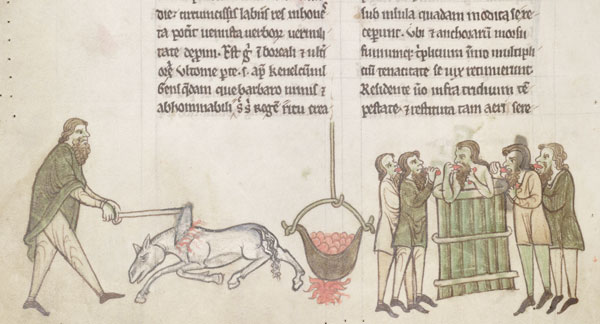
Above: The inauguration of an Ulster king—involving ritual sexual intercourse with a horse, its slaughter and immersion in a great pot containing its flesh—as depicted in Gerald of Wales’s Topography, which, along with Expugnatio Hibernica, was circulating widely in manuscript by the mid-sixteenth century. (NLI)
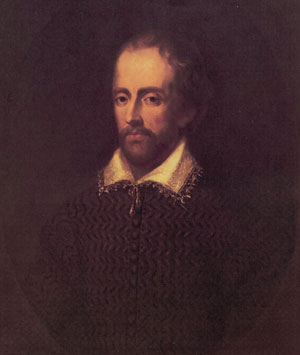
Above: Edmund Spenser—in his A view of the present state of Ireland (written c. 1596) he identified the fundamental mistake as having been that the grip of the invaders was not extended much beyond the coastal counties of the east and south of the island. (Pembroke College, Cambridge)
Tudor agenda
The problem was that it had begun, in the words of Davies, as ‘but an adventure of a few private Gentlemen’, naming FitzStephen, FitzGerald and Strongbow, who, in spite of having brought only small forces with them, had ‘good successe upon the Sea-coasts of Leinster and Mounster’. When Henry II arrived in their stead with his army, according to Spenser in A view of the present state of Ireland (written c. 1596), ‘the Irish were utterly vanquished and subdued, so as no enemy was able to hold up head against his power’. Both Spenser and Davies placed the blame for the subsequent failure to build on this initial success on Henry. For Spenser, the fundamental mistake had been that the grip of the invaders was not extended much beyond the coastal counties of the east and south of the island and that the defeated Irish were allowed to flee from the power of Henry ‘into deserts and mountaines’—or, indeed, were ‘banished into the mountaines’—by the colonisers, and thus escaped from their might. For Davies, the brevity of Henry’s time in Ireland, coupled with his policy of accepting the voluntary submission of Gaelic chiefs, meant that ‘hee departed out of Ireland without striking one blow, or building one Castle, or planting one Garrison among the Irish’. Thus for more than 30 years ‘there was no army transmitted out of England’, leaving the conquest unfinished and no ‘true Soveraignetie’ established over the Irish. Davies claimed that this pattern laid down by Henry, of rulers neglecting to commit sufficient military resources to Ireland, had only been broken in 1597, when ‘a Royall army was sent over to suppresse Tirones Rebellion’ and at last made ‘an universall and absolute conquest of the Irishrie’. Thus the events of the twelfth century were being read in the light of the Tudor agenda of a successful reconquest.
Not all the blame could be laid at the king’s door, however. The contemporary challenge of a recalcitrant Old English community, stubbornly holding to their rights and the old religion, was read back into the past in a more acute way than previously. Internal governance—or ‘the loosenesse of the civill Government’, as Davies termed it—was one of the defects that had ‘hindred the Perfection of the Conquest’. For Spenser, the ‘cheifest abuses which are now in that realme’ had their roots in the original English who had settled beyond the borders of the Pale and adopted the customs, manners and even names of the natives, so that they ‘are almost now growne like the Irish’. Davies accused the major settler landowners in the early years of the colony of driving out their English tenants, ‘poore Freeholders’, through excessive taxation and replacing them with Irish who would agree to the levies: ‘By this meane [sic], the English Colonies grew poore and weake, though the English Lords grew rich and mighty’. In a final blow, they intermarried with the colonised, and through fosterage and gossipred ‘became degenerate and meer Irish in their Language, in their apparel, in their armes and … all other Customes of life whatsoever’. For Spenser, the Old English of his own day, corrupted by this wilful miscegenation, were more deserving of punishment than the Irish: ‘they are more sharpely to be chastised and reformed … for they are more stubborne, and disobedient to the law and government, than the Irish’. Under such attacks, the descendants of the Anglo-Norman élites developed a different view both of the twelfth-century conquest and of their proper role and position under the new Elizabethan dispensation.
Richard Stanihurst
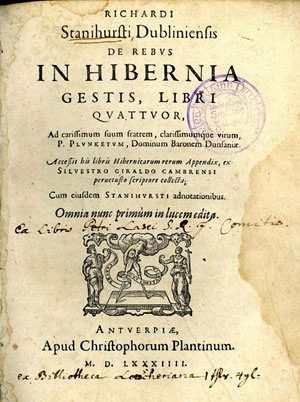
Above: Frontispiece of Palesman Richard Stanihurst’s De Rebus in Hibernia Gestis (1584), which celebrated ‘our ancestors who crossed from Britain to Ireland’.
The most significant response to appear in print was by Richard Stanihurst (1547–1618), a well-connected Palesman whose father was prominent in legal and political circles in Dublin. Stanihurst’s narrative history of his ancestors, De Rebus in Hibernia Gestis (recently edited and translated as Great deeds in Ireland) of 1584, was published in Leiden, where he was studying medicine. The work of an exile, therefore, it celebrated ‘our ancestors who crossed from Britain to Ireland’. While heavily dependent on Gerald’s Expugnatio for his information, Stanihurst’s account was clearly updated to create parallels between the twelfth century and the crisis in which his ethnic community was embroiled, facing a hostile take-over of their power and place by the New English colonists. A detailed narrative of ‘the glorious victories of our ancestors’, it was designed to encourage the Old English to stand up for themselves and display some of that ancestral spirit.
While he disclaimed any deliberate intention to intervene in contemporary political disputes, Stanihurst’s discussions of the challenges of governing the colony in the wake of Henry II’s departure were evidently to be read as a lesson for his own day, when Old English preferences were for governors chosen from among their own community rather than outsiders sent from London. Likewise, his regular emphasis on the probity of the first colonists and their fealty to the Crown could easily be taken as a statement of the continuing and unswerving loyalty of their descendants, in spite of New English assertions to the contrary.
De Rebus in Hibernia Gestis is much more than a political tract in disguise, however. Written as much to show off Stanihurst’s mastery of Renaissance Latin literary style and rhetoric, it employed even more colour and imaginative detail than Gerald had supplied in the Expugnatio. Thus, for example, when Diarmait Mac Murchada travels to France to solicit the assistance of Henry II in regaining his Leinster kingship, he is described as taking on the role of ‘a shabby exile’, dressed in a dark robe and grovelling at Henry’s feet, moaning about his woes and saying that ‘his neighbouring kings were after his blood’. Similarly, Stanihurst’s version of Henry II’s Christmas in Dublin in 1172 builds on Gerald and makes a Renaissance royal feast out of the occasion, including details of the lavish tableware—‘wine bowls with ladles pierced with little golden studs, dishes picked out with pearls and silver candelabra, filled with wax candles’—this ‘enormous outlay of expenditure’ being designed by Henry to dazzle the Irish lords he ‘very charmingly invited’.
While Stanihurst followed Gerald’s line in the Expugnatio of extolling the Fitzgerald contingent among the Anglo-Norman invaders, he did so for reasons not of lineage but rather of pietas towards the current earl of Kildare, who had employed him as tutor to his eldest son. If Gerald in the twelfth century had crafted a narrative to defend his own relatives’ role at the expense of the other Anglo-Norman adventurers, Stanihurst’s agenda, as the Elizabethan conquest gathered pace, was to uphold the honour of the founding ancestors of his whole community. For this reason he tended to present a more favourable view of almost all members of that original group as honourable and upright men.
This is particularly the case in his treatment of Strongbow, who, he alleges, was marked out by ‘the ancient annals’ as ‘the principal agent in the conquest of Ireland’, although it must be said that Stanihurst’s narrative does not really bear this out. This contradiction may be explained by the challenge of being largely reliant, as he was, on Gerald’s hugely informative but far from impartial twelfth-century account, which downplayed Strongbow’s role, while also wanting to accentuate that role in reflecting on developments in his own lifetime. In 1570 Lord Deputy Sidney had ordered the refurbishment of a tomb in Christ Church Cathedral said to be that of Strongbow, which had been damaged when the roof of the building had collapsed. Sidney’s aim was to establish publicly an apostolic succession from the earliest colonists to his own regime, and he commissioned Stanihurst (who was a supporter of Sidney as a worthy governor) to write the monument’s epitaph. This finishes:
‘Bones lie buried but deeds are not silenced.
As long as deeds are not silenced, Strongbow’s fame will last,
His fame remains on earth, his blessed mind in heaven.’
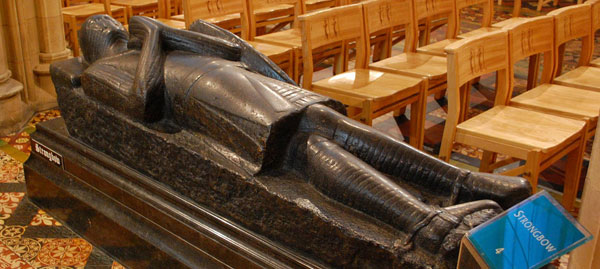
Above: ‘Strongbow’s tomb’ in Dublin’s Christ Church Cathedral, ‘SET: VP: AGAYNE’ in 1570 by the lord deputy, Sir Henry Sidney, to establish publicly an apostolic succession from the earliest colonists to his own regime.
Stanihurst’s peroration in De Res in Hibernia Gestis on the death of Strongbow includes a description of his physical appearance that overturns the picture painted by Gerald of a tall man with reddish hair and freckles, grey eyes, a feminine face, a weak voice and a short neck, whose effeminacy was also reflected in his actions both in battle and civil government, where he lacked the qualities of leadership that betoken real masculinity. In contrast, Stanihurst’s Strongbow was a man whose physical beauty was a match for the very different character delineated: ‘he had blue eyes and a face both amiable and dignified: so surpassing was his face that he left scarcely any scope for praise for beauty even to the most lovely women’. He was ‘brave and experienced’, and ‘by far preferred leisure to war; yet his choice for peace and reluctance for war sprang from strength of judgement, not from meanness of spirit’. In other words, he was the model of the kind of governor that the Old English had in mind, and therefore deserved the honour paid to his memory by Lord Deputy Sidney.
Geoffrey Keating
A parallel attempt to re-imagine the Anglo-Norman conquest from a very different Old English perspective can be seen in Geoffrey Keating’s great work in Irish, Foras Feasa ar Eirinn (c. 1634). Keating (c. 1580–1644), a Counter-Reformation priest of Old English ancestry but Gaelic cultural heritage, aimed to provide a narrative history of Ireland from the creation of the world to the coming of the Anglo-Normans. This was to be an origin legend for the whole Catholic community—whether Gaelic or Old English in origin—for whom he invented a new Gaelic name, ‘Eireannaigh’. Keating’s account of the Anglo-Norman invasion relied on Gerald of Wales and Stanihurst for much of its detail, but his famous Preface excoriates both as belonging to that group of writers who, in their hostile treatment of the customs and manners of the native Irish, are like the beetle who wallows in dung in preference to stooping towards the lily or the rose.
Keating also disassociated himself from his predecessors’ interpretations of the actions of the first invaders who came to Ireland in response to Mac Murchada’s request for assistance. In this section, the culmination of Foras Feasa ar Eirinn, once he has recounted the expulsion of Mac Murchada from Leinster, he largely eschews the narrative approach that he has heretofore adopted when relating the history of the Gael. In a mere six pages he conveys the crux of his parting message, which is that the Old English community does not derive from some of the most iconic Anglo-Norman leaders, excluding here specifically Strongbow, FitzStephen, de Lacy, de Courcy and FitzAdelin. These were ‘five leaders who did more evil deeds than all the Gaels that lived from the time of Brian [Boru] to the Norman Invasion as regards the plundering of churches and clerics, bloody deeds of treachery and violent tyranny’. Adopting an idea to be found in Gerald’s Expugnatio and reported in turn by Stanihurst, he maintains that none of these men left male heirs ‘on account of their own misdeeds’. Rather, the Old English can trace their ancestry back to ‘other leaders … who did much good in Ireland by building churches and abbeys and giving church lands to clerics for their support’. In return for such ‘good deeds’, God ensured that ‘there are many descendants after them at this day in Ireland’, Keating finishing the work with a long list of Old English surnames and famously ending with his own, Kéitinnigh.
Keating’s history was published in English in 1723 and quickly became the standard account of the early Irish past. In an effort to make the work palatable to a Protestant as well as a Catholic readership, the translator stripped out much of its original Catholic thrust and tone, and in places subtly ‘Protestantised’ the text, notably in the section on the Anglo-Normans, where he introduced a providential explanation for both the suffering of the Irish at the hands of the invaders and in turn for the failure of some of the latter to leave male heirs, which was a mark of ‘divine Vengeance’.
Charles O’Conor and Sylvester O’Halloran
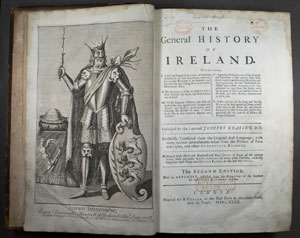
Above: Dermod O’Conor’s 1732 reprint of his English translation (first published in Dublin and London in 1723) of Geoffrey Keating’s Foras Feasa ar Eirinn (c. 1634). Before long it became the standard account of the early Irish past. (RIA)
The Keating model, which devoted most attention to the pre-colonial period of Irish history, was largely followed by two of the most influential Catholic historians of the eighteenth century, Charles O’Conor (1710–91) and Sylvester O’Halloran (1728–1807). As a scion of the hereditary Gaelic kings of Connaught, O’Conor had a personal and family stake in the first conquest, since it was his ancestor, Ruaidhrí Ó Conchobhair, who was the last high-king, bested by the might of the Anglo-Normans. It is hardly surprising, therefore, that in Dissertations on the antient history of Ireland (1753) he preferred to focus far more on the supposed glories of the golden age preceding the trauma of the twelfth century.
Sylvester O’Halloran, a middle-class Catholic doctor, was both younger and from a more modest background than the aristocratic and landed O’Conor. His first major work, An introduction to the history and antiquities of Ireland, was published in 1772, just five years before that festive pageant took place in Dublin’s Crow Street Theatre. While this work, too, paid far more attention to the period before 1169, O’Halloran nevertheless included pen-portraits of the chief protagonists, singling out Strongbow as an intrepid warrior and painting a vivid picture of his marriage to Aoife immediately after the bloody taking of Waterford. For O’Halloran this marriage made Strongbow the rightful king of Leinster on the death of Mac Murchada. His enthusiastic incorporation of the Old English into the line of hereditary Irish kings marks another attempt, post-Keating, to produce an origin legend for all the Catholics of Ireland. Even more acutely, however, O’Halloran’s bravura writing style makes him a kind of poor man’s Stanihurst. Far into the nineteenth century his histories would continue to appeal to an Irish public hungry for colourful stories, in which heroic Gael and intrepid foreign invader both had crucial parts to play in the drama of the Irish past.
Clare O’Halloran lectures in history in University College Cork.
FURTHER READING
J. Barry & H. Morgan (eds), Great deeds in Ireland. Richard Stanihurst’s ‘De Rebus in Hibernia Gestis’ (Cork, 2013).
B. Bradshaw, ‘Geoffrey Keating: apologist of Irish Ireland’, in B. Bradshaw, A. Hadfield & W. Maley (eds), Representing Ireland: literature and the origins of the conflict, 1534–1660 (Cambridge, 1993).
H. Morgan, ‘Giraldus Cambrensis and the Tudor conquest of Ireland’, in H. Morgan (ed.), Political ideology in Ireland, 1541–1641 (Dublin, 1999).
C. O’Halloran, Golden ages and barbarous nations: antiquarian debate and cultural politics in Ireland, c. 1750–1800 (Cork, 2004).
















